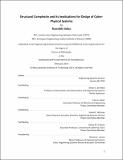| dc.contributor.advisor | Olivier L. de Weck. | en_US |
| dc.contributor.author | Sinha, Kaushik, Ph. D. Massachusetts Institute of Technology | en_US |
| dc.contributor.other | Massachusetts Institute of Technology. Engineering Systems Division. | en_US |
| dc.date.accessioned | 2014-09-19T19:38:42Z | |
| dc.date.available | 2014-09-19T19:38:42Z | |
| dc.date.copyright | 2014 | en_US |
| dc.date.issued | 2014 | en_US |
| dc.identifier.uri | http://hdl.handle.net/1721.1/89871 | |
| dc.description | Thesis: Ph. D., Massachusetts Institute of Technology, Engineering Systems Division, 2014. | en_US |
| dc.description | This electronic version was submitted by the student author. The certified thesis is available in the Institute Archives and Special Collections. | en_US |
| dc.description | Cataloged from student-submitted PDF version of thesis. | en_US |
| dc.description | Includes bibliographical references. | en_US |
| dc.description.abstract | Most modern era software-enabled, electro-mechanical systems are becoming more complex as we demand more performance and better lifecycle properties (e.g. robustness) from them. As a consequence system development projects are becoming increasingly challenging and are falling behind in terms of schedule and cost performance. The complexity of technical systems depends on the quantity of different elements and their connectivity, i.e., complexity means a measurable system characteristic. There are three main dimensions of complexity that emerged in the context of system design and development: (1) Structural Complexity; (2) Dynamic Complexity and (3) Organizational Complexity. Structural complexity pertains to the underlying system architecture or more generally, the enabling infrastructure. Dynamic complexity refers to the complexity of the system behavior or process running on the underlying infrastructure. Organizational Complexity relates to the system development process and the organizational structure of the development team. This dissertation primarily focuses on developing a theoretical framework for structural complexity quantification of engineered systems and subsequently a complexity-based design paradigm of interconnected, complex engineered system. There are four distinct thematic parts in this dissertation: (i) theoretical development of the proposed structural complexity metric, including the metric's qualification as a valid complexity measure based on its mathematical properties; (ii) empirical validation of the proposed complexity metric based on simple experiments and application of the methodology to compute structural complexity of complex engineered systems like jet engines and advanced printing systems; (iii) systemic implications from a complexity management standpoint, including introduction of complexity budgeting for system development and linking actual complexity to human perception of complexity through the notion of complicatedness, and (iv) extension of the proposed metric to system-of-systems and a computational framework for measuring dynamic complexity. The topological complexity metric, C₃ is shown to clearly distinguish between system architectural regimes (e.g., centralized, hierarchical, transitional and distributed). The ball and stick experiment empirically establishes the super-linear relationship between structural complexity (X) and development effort (Y) with exponent, b=1.48. | en_US |
| dc.description.statementofresponsibility | by Kaushik Sinha. | en_US |
| dc.format.extent | 340 pages | en_US |
| dc.language.iso | eng | en_US |
| dc.publisher | Massachusetts Institute of Technology | en_US |
| dc.rights | M.I.T. theses are protected by copyright. They may be viewed from this source for any purpose, but reproduction or distribution in any format is prohibited without written permission. See provided URL for inquiries about permission. | en_US |
| dc.rights.uri | http://dspace.mit.edu/handle/1721.1/7582 | en_US |
| dc.subject | Engineering Systems Division. | en_US |
| dc.title | Structural complexity and its implications for design of cyber-physical systems | en_US |
| dc.type | Thesis | en_US |
| dc.description.degree | Ph. D. | en_US |
| dc.contributor.department | Massachusetts Institute of Technology. Engineering Systems Division | |
| dc.identifier.oclc | 890199003 | en_US |
